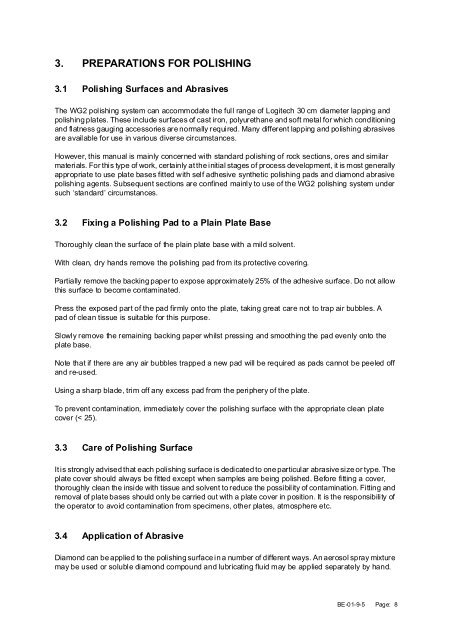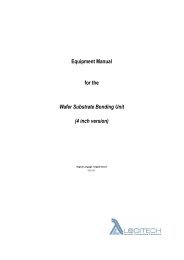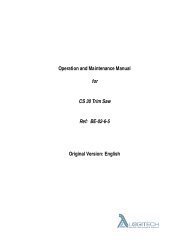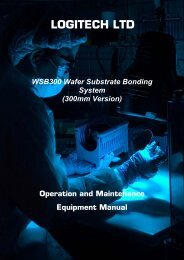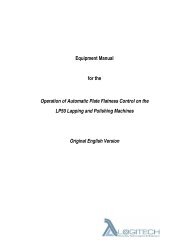Safety Precaution Sheet To be read carefully before use - Logitech Ltd
Safety Precaution Sheet To be read carefully before use - Logitech Ltd
Safety Precaution Sheet To be read carefully before use - Logitech Ltd
You also want an ePaper? Increase the reach of your titles
YUMPU automatically turns print PDFs into web optimized ePapers that Google loves.
3. PREPARATIONS FOR POLISHING<br />
3.1 Polishing Surfaces and Abrasives<br />
The WG2 polishing system can accommodate the full range of <strong>Logitech</strong> 30 cm diameter lapping and<br />
polishing plates. These include surfaces of cast iron, polyurethane and soft metal for which conditioning<br />
and flatness gauging accessories are normally required. Many different lapping and polishing abrasives<br />
are available for <strong>use</strong> in various diverse circumstances.<br />
However, this manual is mainly concerned with standard polishing of rock sections, ores and similar<br />
materials. For this type of work, certainly at the initial stages of process development, it is most generally<br />
appropriate to <strong>use</strong> plate bases fitted with self adhesive synthetic polishing pads and diamond abrasive<br />
polishing agents. Subsequent sections are confined mainly to <strong>use</strong> of the WG2 polishing system under<br />
such ‘standard’ circumstances.<br />
3.2 Fixing a Polishing Pad to a Plain Plate Base<br />
Thoroughly clean the surface of the plain plate base with a mild solvent.<br />
With clean, dry hands remove the polishing pad from its protective covering.<br />
Partially remove the backing paper to expose approximately 25% of the adhesive surface. Do not allow<br />
this surface to <strong>be</strong>come contaminated.<br />
Press the exposed part of the pad firmly onto the plate, taking great care not to trap air bubbles. A<br />
pad of clean tissue is suitable for this purpose.<br />
Slowly remove the remaining backing paper whilst pressing and smoothing the pad evenly onto the<br />
plate base.<br />
Note that if there are any air bubbles trapped a new pad will <strong>be</strong> required as pads cannot <strong>be</strong> peeled off<br />
and re-<strong>use</strong>d.<br />
Using a sharp blade, trim off any excess pad from the periphery of the plate.<br />
<strong>To</strong> prevent contamination, immediately cover the polishing surface with the appropriate clean plate<br />
cover (< 25).<br />
3.3 Care of Polishing Surface<br />
It is strongly advised that each polishing surface is dedicated to one particular abrasive size or type. The<br />
plate cover should always <strong>be</strong> fitted except when samples are <strong>be</strong>ing polished. Before fitting a cover,<br />
thoroughly clean the inside with tissue and solvent to reduce the possibility of contamination. Fitting and<br />
removal of plate bases should only <strong>be</strong> carried out with a plate cover in position. It is the responsibility of<br />
the operator to avoid contamination from specimens, other plates, atmosphere etc.<br />
3.4 Application of Abrasive<br />
Diamond can <strong>be</strong> applied to the polishing surface in a num<strong>be</strong>r of different ways. An aerosol spray mixture<br />
may <strong>be</strong> <strong>use</strong>d or soluble diamond compound and lubricating fluid may <strong>be</strong> applied separately by hand.<br />
BE-01-9-5 Page: 8


